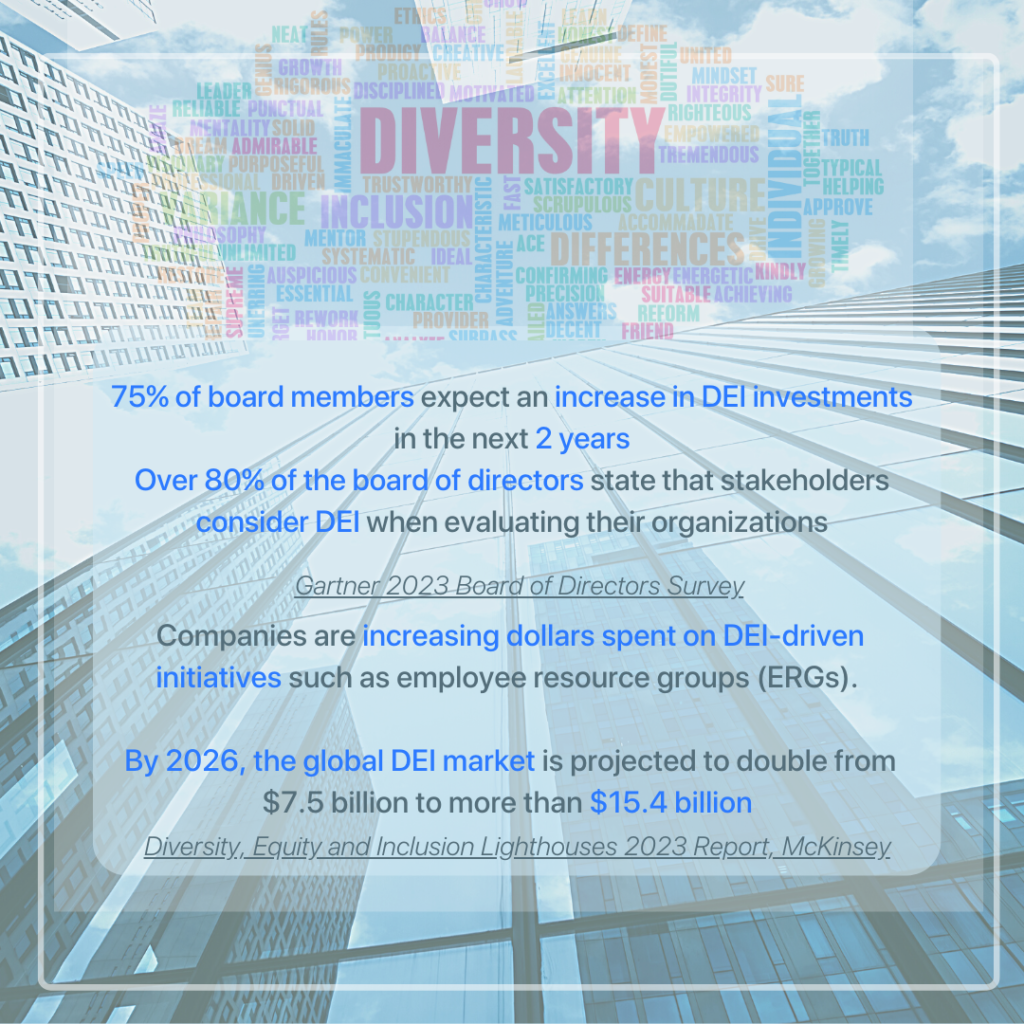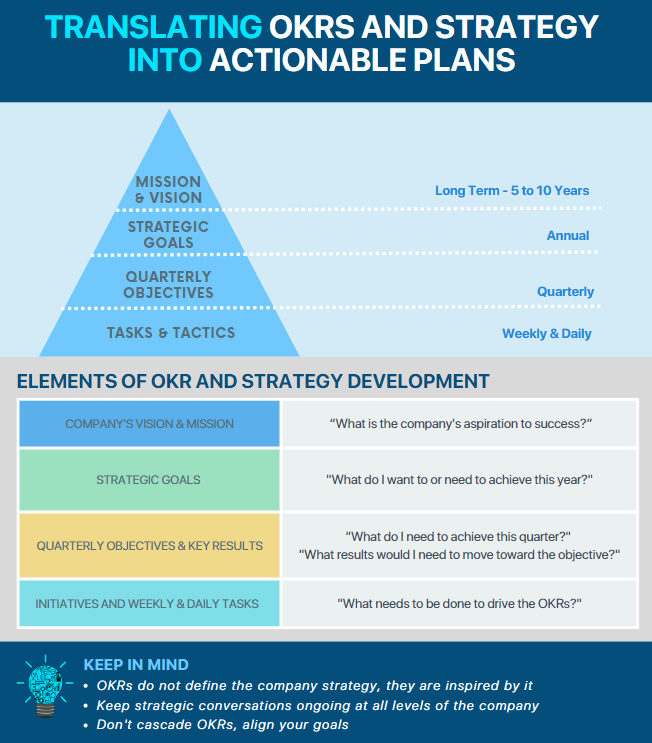The OKR journey can be intense. While you may be focusing on broader areas such as business improvements, growth, and success, are you allowing everyone’s voice to be heard? Are your company’s goals inclusive or does it have an implicit bias towards one group?
The essence of OKRs is more than focusing on increasing profits and revenues. It’s about approaching the conversation on Key Results with a different perspective. Use OKRs to build the company culture you envision – one that can be innovative and inclusive.
DEI OKRs – Empower the Workforce of the Future
Diversity and inclusion OKRs include those objectives that ensure the work environment is safe and inclusive for employees and that they have equal opportunity to advance in the company. Creating diversity and inclusion goals and objectives is a balancing act of taking into consideration the viewpoints of all stakeholders while building a structure to execute strategy.

🚩 If your company doesn’t give importance to DEI OKRs as much as the objectives of other business functions, it should be a red flag. Because for the company to thrive; diverse employees have to grow.
DEI initiatives implemented across industries have resulted in quantifiable, sustainable, and significant impact. Modern leaders have the resources and knowledge to contribute greatly – all they need is the motivation and commitment to implement DEI initiatives and have an impact on the business community.
Developing diversity and inclusion goals and objectives requires a thoughtful process. The Objectives and Key Results (OKR) framework is a proven way that many leaders use to align their goals and make impactful changes in their companies.
Become an OKR expert in the Learning Center
Here are five success factors of implementing DEI goals and how OKRs can play an important role in achieving them.
5 Success Factors of DEI OKR Implementation
To ensure meaningful progress toward achieving DEI-driven OKRs, engagement at every level of the company is essential – from the CEO to individual stakeholders. Some of the factors that can guarantee the success of DEI OKR implementation include:
1. Promote invested leaders and ensure overall accountability
Change requires leaders to be convincing and committed. When defining priority areas it is not enough for leaders to develop a strategy, and allocate resources and budgets. They must be completely invested and accountable for the outcomes of DEI initiatives. Commitment from senior executives and leaders can highlight the importance of the initiative making it more likely that it will succeed.
Promoting commitment and accountability through OKRs
Leaders are as accountable as the rest of the organization when it comes to business growth and success. Through sprint planning, execution meetings, and regular check-ins, OKRs hold everyone more accountable for the outcomes they aspire to achieve. Committing to delivering the top priorities and sharing progress with the rest of the company can promote accountability.
2. Identify opportunity areas and understand fundamental challenges
Creating DEI OKRs begins with identifying the underlying causes affecting employee groups and using data-driven insights to understand the challenges in depth. Input from employee feedback surveys, focus groups, and interviews can facilitate a better understanding when creating diversity and inclusion goals and objectives.
Identifying opportunity and improvement areas using OKRs
When understanding challenges the difficult part can be identifying specific focus areas, without which the DEI strategy cannot be put into action. The OKR framework drives focus toward making meaningful improvements and enables setting measurable key results. DEI goals are company specific and identifying relevant opportunity areas through OKRs can help prioritize goals and action plans.
👉 Want to know how to plan better using OKRs? Clearly articulate your DEI objectives and keep you team focused using this Goal Planning Template
3. Define success and set measurable goals
Once an opportunity area is prioritized, the next step is to define success and create measurable goals to guide initiatives. Articulate why a particular DEI opportunity area is given focus and how it is aligned with the company’s vision and mission. Defining success and communicating the purpose of goals can increase employee engagement and productivity.
Using OKRs to align measurable goals
One of the most important aspects of OKRs is goal alignment. It can answer questions such as, “How are DEI OKRs aligned with the company’s vision and business strategy?” “What are the business outcomes that can be achieved by implementing DEI objectives?” Moreover, creating measurable Key Results for every Objective provides quantifiable metrics to make a more effective assessment of success.
👉 Find out how to create measurable and actionable Objectives and Key Results that can be difficult to deliver but not impossible to achieve.
4. Design solutions to align change strategies
To effectively support sustainable changes, it is essential to have solutions that address key challenges and enforce process changes. This involves empowering employees and a diverse team with the resources, knowledge, and skills to encourage contribution and drive the desired change. Driving DEI initiatives especially require a shift in mindset, a change in workplace culture, and alignment of goals.
Designing strategies for change with OKRs
OKRs enable adjusting short-term goals for long-term strategies. By assigning responsibility for goals – from leadership to individual contributors – OKRs can empower everyone to contribute to the change. Moreover, it allows aligning the goals of different teams with the overall company strategy – this makes it easier to implement changes collectively.
👉 Read how to align your OKRs and encourage collaboration at every level of the company.
5. Track the progress of DEI goals regularly
For leaders to monitor the effectiveness of solutions it is important to measure progress. Tracking progress helps to understand how to adjust strategies and goals to increase impact. An impactful way to track DEI goals can be to use status tracking and reporting automation tools to reduce the time spent on monitoring progress and building reports.
Automating progress tracking using OKRs
Adopting the PPP methodology (Plans, Progress, Problems) to build status reports and implementing it in your OKR software is a great way to automate progress tracking. This will give you an overview of your teams’ progress and challenges that need to be addressed.
👉This video shows how you can use the PPP methodology and the best practices to adopt.
OKRs + Weekly Planning = Formula to Win
Free DEI Questions Checklist Template
Focusing on DEI OKRs can provide leaders with an opportunity to make an impact and drive real change.
Download and refer to this checklist of questions to get started on your DEI goal-setting process.
DEI OKR Examples: Get Inspired to Drive Change
| Example 1- DEI Goals Understanding 🚀Objective: Understand and improve the outlook of DEI goals internally in the workplace ➖ KR1: Conduct an internal assessment to understand the diversity of current employees and create a report on the findings ➖ KR2: Implement an internal employee survey on DEI challenges and attain a 90% response rate ➖ KR3: Ensure at least 80% of senior managers and leaders participate in a mentor program |
| Example 2 – Diversity Objectives 🚀Objective: Increase and improve diversity and inclusion in the company to include employees of different ages, gender, culture, and other background traits ➖ KR1: Rework 100% of current job descriptions to have inclusive language to attract diverse candidates ➖ KR2: Achieve a balance of employing an equal percentage of men and women in all teams ➖ KR3: Ensure the leadership positions have applicants from diverse backgrounds |
| Example 3 – DEI Brand and Promotion Strategy 🚀Objective: Amplify DEI-driven initiatives externally as a brand ➖ KR1: Post 3 DEI-related blog posts in the quarter ➖ KR2: Promote DEI initiatives on social media and achieve an engagement rate above 5% ➖ KR3: Conduct and promote 3 interviews of DEI success stories within the company |
| Example 4 – DEI Education 🚀Objective: Improve the knowledge about DEI issues and make a more sensitive and inclusive workplace ➖ KR1: Implement a company-wide employee education program in the quarter to advance equitable career advancement opportunities ➖ KR2: Conduct sensitivity and unconscious bias training and ensure 100% participation ➖ KR3: Implement interview training modules and ensure 100% completion by hiring managers |
Turn DEI Goals into Action with OKRs
Achieving impactful change requires meaningful action – not from one individual or group – collectively. OKRs play a vital role to align all resources and achieve diversity and inclusion goals and objectives. It allows inclusive conversations about strategy, adds structure to the goal-setting process, creates a measurable way to track outcomes, and encourages consistent commitment from teams and leadership.
👉 Translating DEI strategies into action requires alignment. Strategic alignment ensures everyone is engaged and invested in the purpose of the initiative. Find out how to translate your strategy into action plans and make your DEI goals matter.

Making impactful improvements and creating actionable DEI-driven goals can be challenging. A dedicated OKR software can make it easier to align and achieve your diversity and inclusion smart goals.